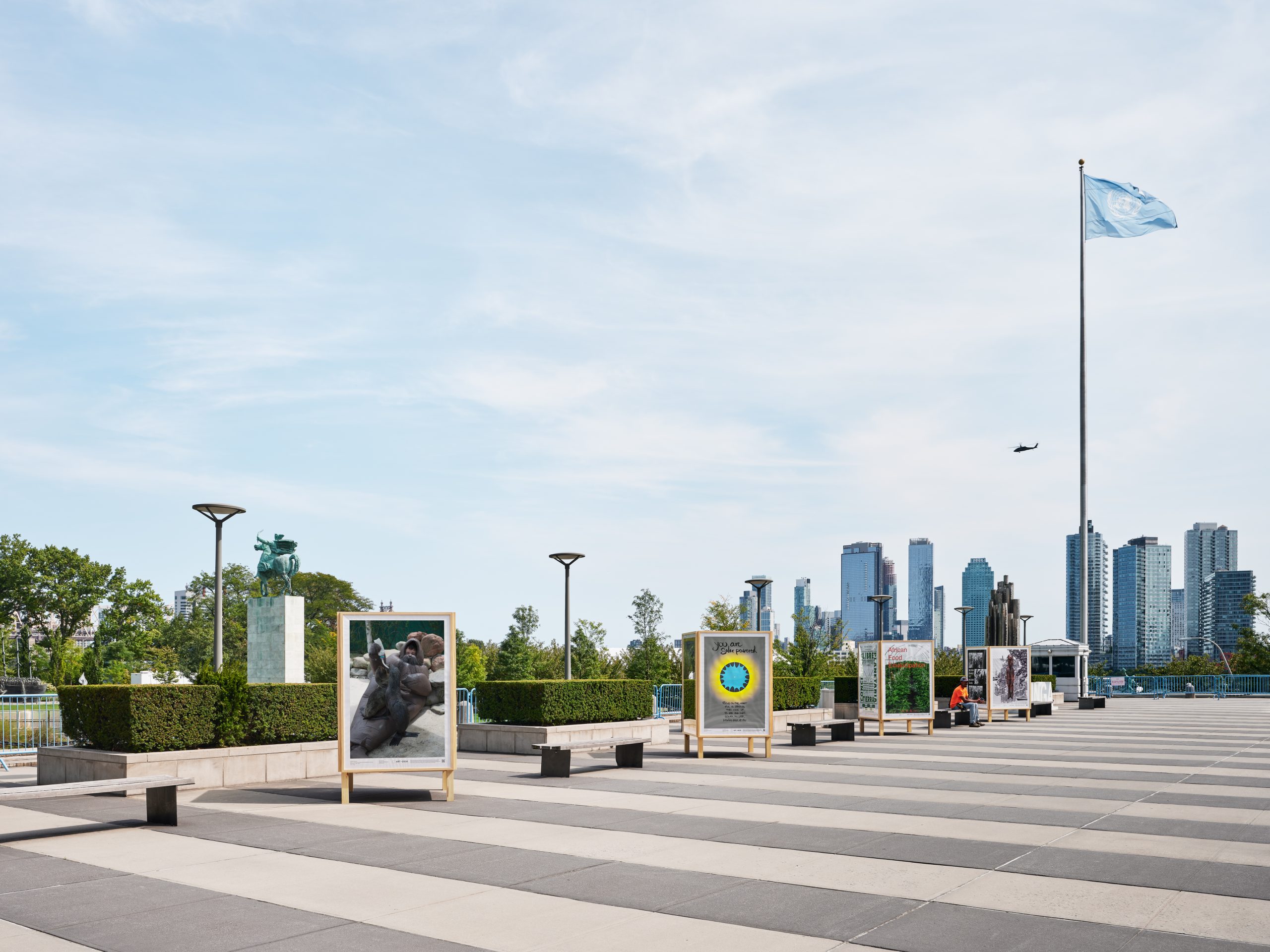This week, the United Nations General Assembly gathers in New York for the United Nations Summit of the Future, focused on shaping a more sustainable future for the planet and addressing both current and future global challenges. In tandem, ART 2030, a non-profit founded by collector and philanthropist Luise Faurschou, has unveiled its latest project, “Future Ours,” which showcases the visions of a sustainable future imagined by twenty-one contemporary artists and art collectives on the UN Plaza. Co-curated by Patricia Domínguez, Hans Ulrich Obrist and Jeppe Ugelvig, the project spans generations and artistic styles, featuring pioneers in ecological art like The Harrison Studio, alongside Olafur Eliasson, Maya Lin, Yinka Shonibare CBE, Suzanne Treister and Otobong Nkanga, as well as younger voices like the Institute of Queer Ecology.
The project debuted on September 20, strategitically placed where diplomats and politicians will pass on their way to make decisions about the global future. It then went public, taking over hundreds of JCDecaux bus shelters across New York’s five boroughs to engage both the public and political leaders, sparking crucial conversations about the future all around the city.

“We need art at the center of the dialogue,” Luise Faurschou told Observer at the opening press conference. “I think it’s important that it’s a global group of artists because we have to respond collectively to the problems, but we also have to look at them from many different perspectives. We trust the transformative power of art.” Throughout the event, Faurschou emphasized how connecting art with sustainable goals is crucial when addressing collective challenges. “Future Ours” powerfully explores how art can serve as a unique tool for critical world-building, weaving a dialogue between social, economic and ecological equity for the global community, while assuming new social, political and financial roles. “These artists give us this gift of vision and help us imagine what the future can be,” she continued. “They’re already responding to what will be discussed at the UN Summit of the Future.”
International curator Hans Ulrich Obrist echoed this sentiment, telling Observer that the only way to tackle the major challenges of the 21st Century is through interdisciplinary collaboration, as the problems themselves are multidisciplinary. “I was reading a book by Roman Kajaani, which just came out, and he talks about the need to address all these different crises: the climate emergency, the necessity for tolerance, moving beyond consumer habits and tackling inequality,” he said. “We can only solve these issues if we break down silos of knowledge and work together across different fields. What’s amazing is that these artists, through their collectives, bring together science, art, technology and environmentalism.”
Many of the artists involved in this project indeed work interdisciplinarily, often within collectives or by forming new structures that unite organizations, foundations, think tanks and project spaces, bringing together experts from different fields and engaging with this knowledge through art. Crucially, most of these projects in “Future Ours” are durationally structured for the long term. “They operate on ‘the long durée,’ as described by French historian Fernand Braudel: they set their own temporality,” Obrist explained. The artists also focus on the local to address the global, starting with the impact on their immediate communities and creating models that inspire solutions on a broader scale. Obrist recalled a conversation with his friend, philosopher and poet Édouard Glissant: “He once told me we need to think about the local. Many of these projects are local, but not in a way that excludes others. Localism often leads to exclusion in the name of celebrating roots, but these roots expand and connect elsewhere. So it’s local, but not localist. It’s local with a global perspective.”

Indigenous collective MAHKU (Huni Kuin Artists Movement), which recently took over the facade of the Giardini at this year’s Venice Biennale, works on land regeneration and reappropriation. Others focus on purification at a collective level, like Otobong Nkanga’s project Landversation, which expands the concept of “Land” beyond soil and territories to address human connectivity and conflicts over the spaces we inhabit, exploring solutions through simple gestures of innovation and repair. Similarly, Yinka Shonibare’s foundation fosters community-driven art and design approaches to planting, farming and environmental care, while Olafur Eliasson’s projects intersect directly with environmental activism.
Taking place during the 79th United Nations General Assembly, the Summit of the Future is a once-in-a-generation opportunity for world leaders to come together to find solutions and discuss alternatives for a more sustainable, diverse and equitable future. The summit will culminate in the approval of an international cooperation pact addressing current and future challenges. In this context, “Future Ours” highlights the trust placed in artists to use their practices as tools for vision, reflection and action. “We need artists’ vision and perspective in society; we believe artists should have a seat at the table where decisions are made,” concluded Obrist.
“Future Ours,” initiated by ART 2030 and Kunsthal Charlottenborg in partnership with JCDecaux North America, will travel to Denmark in 2025 after its New York presentation, where it will be exhibited at the Kunsthal Charlottenborg Biennale in Copenhagen and featured on AFA Decaux infrastructure across the country’s streets, train stations and bus stops.
